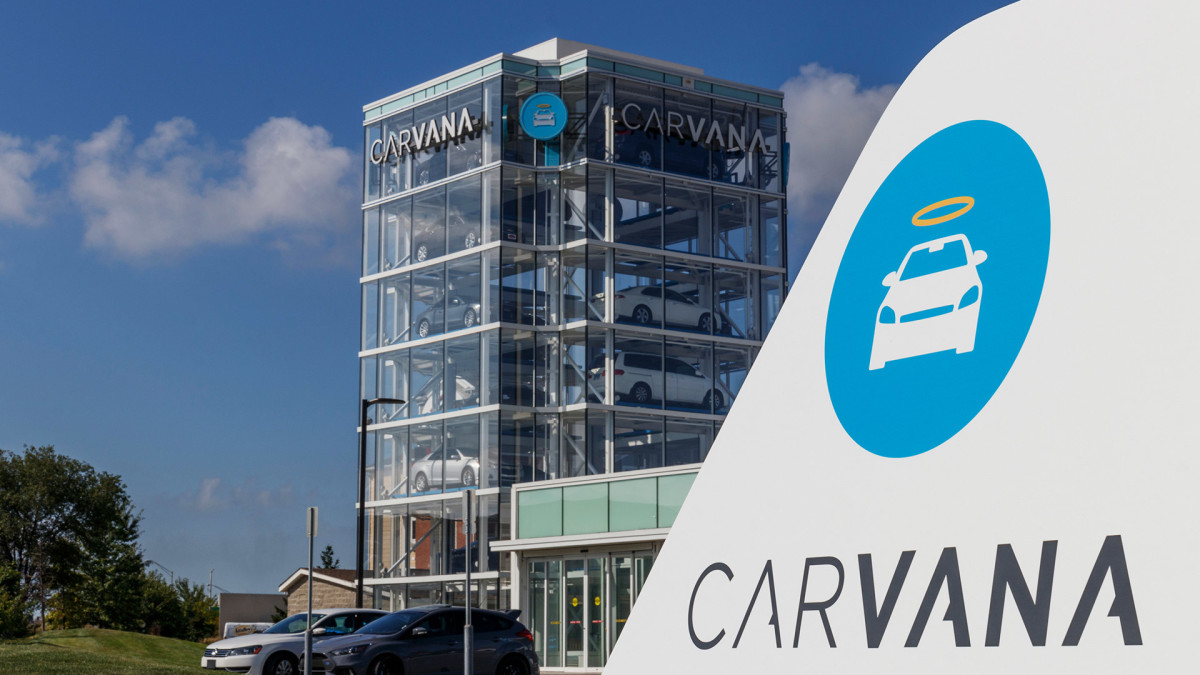It is a buoyant red in the portfolio of the shareholders of Carvana, the online used car platform.
In one year, their shares have lost most of their value, no doubt giving them the impression that they have invested in a penny stock.
And yet, Carvana (CVNA) – Get Free Report had the wind in its sails at the end of 2021.
The company was Amazon’s counterpart in the automotive industry.
It had become the place where consumers went to buy or sell a used vehicle. The company’s business model was in perfect symbiosis with an economy that had moved online due to the restrictions to limit the spread of the pandemic.
The sector of used cars had a bad reputation, but Carvana vowed to change it with its innovative business model, in the hope that it would win the trust of customers who are looking for a used vehicle. The Tempe, Arizona-based company says it has found the formula that will make buying a second-hand car a satisfying transaction for its customers.
One-Stop-Shop
Carvana wants to be the one-stop-shop for used cars. In fact, the company offers its customers a turnkey purchasing solution: it takes care of the inspection of the cars it buys for resale, repairs if necessary, financing and selling. Nothing original at this point, with some used car retailers offering the same services today.
Here comes the difference: the inventory is accessible through the company’s virtual catalog. Each vehicle can be viewed under a glass thanks to patented 360-degree imaging technology. The customer can have their car delivered to their home.
They can also go to one of the giant Carvana vending machines, present in more than 25 American cities, in order to take possession of their new purchase. Yes, the collection of 24 used car vending machines is a Carvana specialty.
Using one of these vending machines, the customer can easily pick up their new car while dropping off the old one. Alternatively, Carvana will deliver the purchased vehicles directly to the consumers. Each vehicle comes with a seven day return policy.
This model gave Carvana an advantage, because the U.S. used car market is extremely fragmented: there are currently about 43,000 used car dealerships, nearly two-thirds of which are independent.
The problem is that the company didn’t seem to have anticipated headwinds: the downturn in the used car market, in particular, a possible recession and a sudden rise in interest rates, which would make car loan financing expensive, represent a normalization of the new market.
The Manheim Used Vehicle Value Index, which monitors prices of used cars sold at U.S. wholesale auctions, saw a drop of 15.6% in November, from record levels in January.
Many car manufacturers such as Tesla (TSLA) – Get Free Report, for example, have recently reduced their prices, going so far as to offer large discounts to consumers, a sign that the supply of new cars is greater than demand. Faced with attractive new offers or promotions, it is logical to consider that consumers will abandon the second-hand market.
A Recession Is Looming
According to Cox Automotive, it’s estimated that used car retail sales fell 1% in November from the month before and are down 10% year-over-year. It’s also estimated that the total used market was likely to finish the year down 12%, from the 40.6 million figure in 2021.
All this is the opposite of what was happening during the pandemic: at the time, the shortage of chips had a big impact on the inventories of car manufacturers who could not produce as much as they wanted. On the demand side, consumers who wanted to avoid public transit and any crowded mode of transport would switch to the purchase of a vehicle as long as the money was available. The federal government had flooded the economy with stimulus in the form of checks to households.
All of this resulted in a spike in used car prices. In 2021, the second-hand car market posted a 41% increase, a real record. Carvana could therefore smile, because this situation was a very good deal for the firm.
This is no longer the case today. Carvana’s model is based on the fact that the company must sell more used vehicles than it buys. Not only has the company sold fewer cars, but it has also seen the value of the cars in its inventory decrease. This trend is not about to stop, as many economists and business leaders anticipate a recession in 2023.
As a result, the company that had a meteoric rise, is now experiencing an equally dramatic fall. The stock has lost 98.4% of its value and is currently trading at $3.72. It is no longer far from a penny stock. The market capitalization has completely collapsed, from $41 billion in December 31, 2021 to over $600 million currently.
‘Substantial Liquidity’
The question now is no longer whether Carvana will recover, but more when the company will file for Chapter 11 bankruptcy. A group of creditors — the private-equity firm Apollo Global Management (AAM.P.A) , and Pacific Investment Management, known as Pimco — have already taken the lead in signing a pact to negotiate together to try to get their money in the liquidation or bankruptcy proceedings.
These investors hold about $4 billion of Carvana’s $6 billion unsecured debt. The company is also said to be in discussions with lawyers and investment banks to explore its options for managing its debt.
“Carvana is not involved in any cooperative agreement amongst bondholders and we will not be addressing any questions that arise from actions taken by such bondholders,” a spokesperson told TheStreet on December 7.
“We have substantial liquidity to get us there. In no way does today’s news change that strategy.”
The problem is that the Fed plans to continue raising interest rates in 2023.









